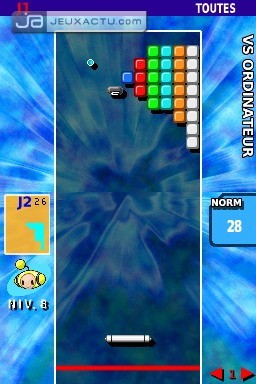
An unlicensed version for Texas Instruments' popular TI-83 calculator is also available, reflecting, in many ways, the advances in computer technology since its original release. A version for the Nintendo DS handheld, titled Arkanoid DS, was released in Japan, with a North American release on August 1, 2008. Computer conversions were published by Imagine. Commodore 64 conversion of Arkanoid is known as the first game for the system to feature music that used digitized samples (composed by Martin Galway). 16-bit versions had identical graphics as the arcade game. Arkanoid Returns and a sequel, Arkanoid Returns 2000, were released in Japan for the PlayStation. A Super NES version called Arkanoid: Doh It Again was released in 1997. A Macintosh version was released in 1987 and a port was released for the TRS-80 Color Computer in 1989. A console port on the NES was also popular, and the game was also ported for 16-bit computers Amiga, Atari ST, Apple IIGS and IBM PC. Many of the 8-bit computer ports (ZX Spectrum, Amstrad CPC 464, Commodore 64, BBC Micro, MSX, Atari 8-bit, Apple II) were very popular in Europe in the 1980s. The reviewers gave the game 5 out of 5 stars. The game was reviewed in 1989 in Dragon #144 by Hartley, Patricia, and Kirk Lesser in "The Role of Computers" column. The Japanese DS version features an optional paddle controller that connects in the Game Boy Advance slot, but the paddle controller is not being released in America. Latter-day MAME arcade cabinet developers have created customized spinner controls to further simulate the arcade experience, although the Arkanoid controller had quirks which have made it difficult to achieve 100% reproduction.

While the game may be played with the standard digital NES control pad, optimum gameplay is achieved with the Vaus Controller. The NES version of Arkanoid was originally packaged with what's considered one of the rarest of all NES controllers, the Vaus Controller: a small gray controller featuring one button, a small spinner (with limited turn radius), an adjustment port, and the Taito logo. Digital controls (many joysticks and control pads, and keyboards) are considered less desirable than analog controls (most mice, trackballs, and paddles) while digital controls limit the player to single-speed control, analog controls allow the player to move the Vaus at nearly any desired speed across the screen. The two basic control methods are digital and analog. The controls used by various conversions differ from machine to machine, and some conversions allow for multiple control methods. The ultimate goal is to reach the final confrontation with Doh, who holds the Vaus ship captive in these playfields.īecause of the game's popularity, five other versions of the game were developed for the market: Tournament Arkanoid and Revenge of Doh ( Arkanoid II) both in 1987, Arkanoid - Doh It Again and Arkanoid Returns both in 1997, Arkanoid DS in 2007, Arkanoid Live, and, most recently, Arkanoid Plus! on WiiWare.

Occasionally, a block will release a power-up capsule that will give the player various abilities: expanded Vaus, capture and release, slowed-down energy ball, multiple energy balls, Vaus with lasers, warp into the next screen, and an extra ship. Some blocks require two hits in order to be destroyed, while some blocks are indestructible. The player must keep the ball in play or else a Vaus ship is lost. System can be found here and games for the Pla圜hoice-10 can be found here.The player controls the Vaus, a paddle-shaped ship that must deflect an energy ball toward an arrangement of blocks in the playfield to destroy them. This list consists of dedicated arcade games developed by any of Nintendo's development divisions or published in any region by Nintendo itself. Main article: Amiibo § List of Amiibo Arcade

Toys and cards List of toys and cards published by Nintendo 3.2 Nintendo Entertainment System and Famicom.


 0 kommentar(er)
0 kommentar(er)
